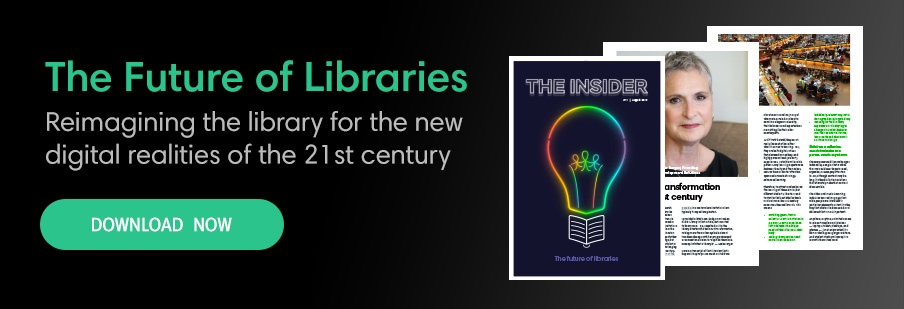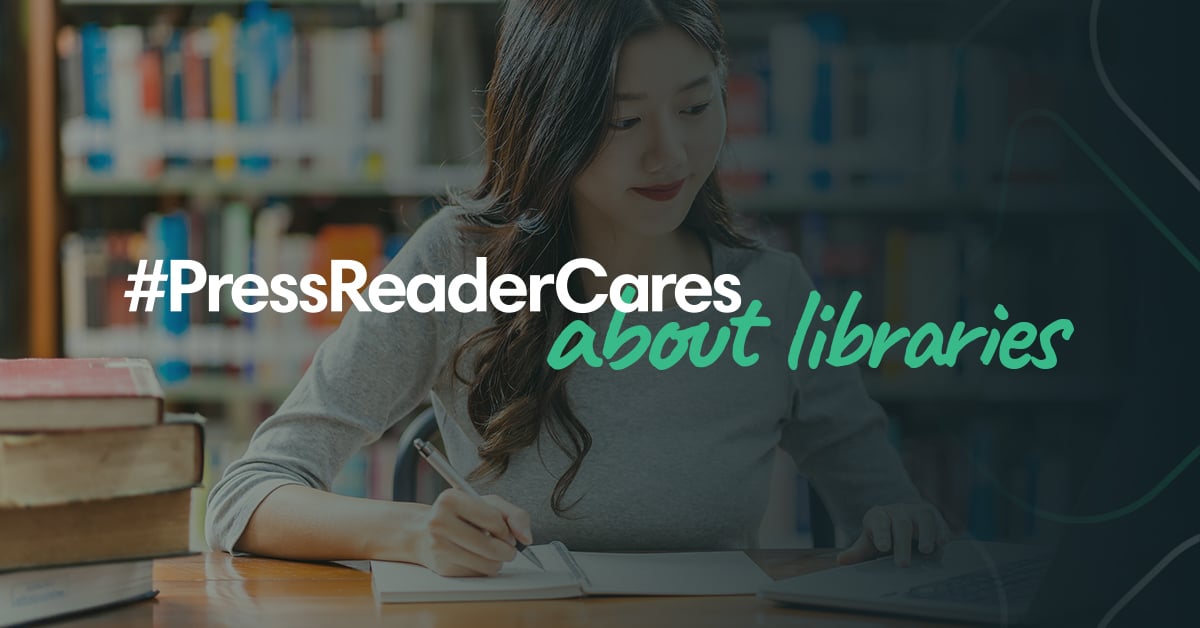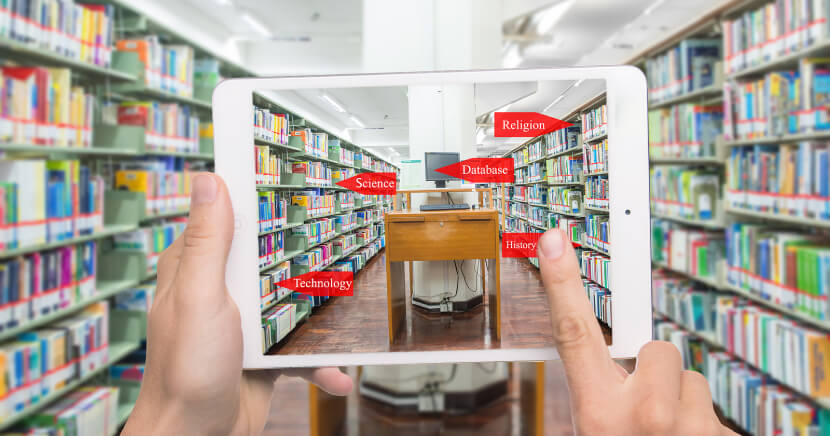Back in 2012 an OCLC (Online Computer Library Center) study found that most academic librarians thought the primary reason students and staff used their services (borrowing materials) would shift to using the library to access information online. And they were, of course, right.
There’s been a dramatic change in the way people discover and access content - whether it’s videos, music, news media, or peer-reviewed journals. But it’s not just about smartphones and tablets versus printed newspapers, journals, and glossy magazines. It’s about immediacy, relevancy, experience, and trust.
It’s about giving students, researchers, and faculty access to the most relevant information in a way that makes sense to them as individuals.
Higher education is shifting because its core constituents – students – are starting to behave more like customers and are less forgiving of some of the inefficient and ineffective aspects of the academy not tailored for a strong customer experience.”
Andrew Roth, President Emeritus
Notre Dame College
This shift has had a major impact on the business models behind many industries including airlines, hotels, cars, newspapers, magazines, literature, movies, music, groceries, and clothing. These models have been transformed from owning to sharing, from buying things to buying experiences, from paying for the whole to paying for a piece, and from individual subscriptions to all-you-can-consume.
Fundamental changes in human behavior are the catalysts behind these transformations and libraries are not immune to them. They must evolve quickly and transform their own archaic business practices and models or be left behind.
If you build it, will they come?
Brick and mortar libraries constantly compete with the internet for people’s time and attention. And as more and more students use Google and other web sources for their research over library resources, the closer to obsolescence the institution comes.
|
“Undergraduates’ well-documented reliance on Google for academic research is strongly supported by the results of this longitudinal cohort study. In each semester, at least one-third of the participants said they started their research on Google or another search engine, with more than two-thirds starting there as first-semester freshmen. Similarly, at least 25 percent of students in any given semester said they used web sources for the majority of the information in their papers, with 70 percent doing so in their first semester.” Undergraduates’ Use of Google vs. Library Resources A Four-Year Cohort Study |
So if the world’s knowledge is within reach of a student with a keyboard, do they really need libraries anymore?
According to a recent study by the Association of College and Research Libraries, the resounding answer is, “Yes!” Four years of research showed there is a positive correlation between the use of an academic library and a student’s success.
- Use of academic library spaces relates positively to student learning, retention, and success
- Library instruction adds value to a student’s long-term academic experience, and according to the Cohort study, helps shift students’ research behavior from searching the web to exploring library resources
- Libraries also promote academic rapport and student engagement
The academic library has much to offer students, but all of that value will be for naught if students aren’t drawn to it. And if we’ve learned anything from the prolific research about GEN Ys and Zs (many of whom are enrolled or about to enroll in college or university), their behaviors and expectations are nothing like their older counterparts.
And if truth be told, they’re not really like each other either when it comes to learning. Yes, they are both digital natives that demand immediacy and highly personalized (relevant) experiences. But while millennials prefer 2-way learning experiences between faculty and themselves, GEN Zs have a shorter attention span and crave technology-enhanced learning.
Therefore, to attract and enhance the learning of these similar, but different students, libraries need to start to think outside the book and act more like 21st-century consumer-focused brands. This means:
- Switching gears, from a collection-centric institution to a person-centric experience that addresses the unique needs of their diverse student body
- Making library services and content available in an individually-relevant way, not a demographically-targeted way
- Focusing on the discovery experience and adapting to changes in student behavior over their academic lifetime, because those behaviors will continue to change
Shift from a collection-centric institution to a person-centric experience
There are over 60 billion web pages indexed by Google. That’s more than we could ever hope to read, organize, or even pay attention to. So, although content may be king, it’s the distribution solutions that ultimately make that content discoverable.
The video and music streaming industries learned long ago that while people are interested in particular pieces of content, it’s the way that content is discovered and delivered that’s most important.
Anywhere, anytime, unlimited access to relevant media on all devices – laptops, tablets, desktops, and phones – is not only wanted, it’s demanded by younger generations. And students today will accept no less with the written word.
Open Educational Resources (OER)
Open Educational Resources, along with more affordable course content initiatives, have started to pave the way to a better student experience, and libraries must play a leadership role in that. In their institutional OER programs libraries need to find innovative ways to let students self-direct their learning and access content when, where, and how they need it.
Libraries need to invest in more comprehensive, user-friendly platforms that can help students navigate through an ocean of data and discover the right content at the right time.
Digital Media

In the past, libraries thought that offering a small selection of printed media along with a few select digital editions of periodicals and newspapers was sufficient to support the student body and faculty. At that time, Newspapers in Education programs were considered adequate for meeting the limited demand for local and national news content.
But today’s expectations far exceed these antiquated single-source solutions. The world of knowledge and news is now at students’ fingertips, and they expect unlimited, uninhibited, free access to all it has to offer through the library. Unfortunately, the chaotic nature of the web makes discovery of relevant information almost impossible, despite the best efforts of librarians.
It’s time for schools and librarians to critically analyze the relationships between digital information, audiences, and platforms and give their students unfettered, relevantly-curated access to the world’s digital content – anytime, anywhere.
Now that’s an extremely large ask and one that libraries can’t even hope to answer on their own. Which is why technology partners are critical collaborators in making sense of a senseless digital universe.
Just like Netflix answered it for video, Spotify for music, and Amazon for books, Overdrive, Google Scholar, Academic Search Premier, and PressReader have the answers for eBooks, scholarly literature, journals, and newspapers and magazines.
Platforms that aggregate content from tens of thousands of trusted sources making it easy for students to access information through multiple portals and authentication methods (e.g. IP addresses, referral URLs, geo-fencing, etc.)
Make library services and content available in an individually-relevant way
“Content without discovery is like playing chess without a board.”
Sarah Richards, Content Design
Help them find the right content
The music and video industries have adapted to new ways people consume content – by individual songs instead of albums, or by binge-watching a series instead of waiting for weekly episodes.
Newspapers and magazines use aggregated platforms to facilitate distribution and discovery of content in a myriad of forms.
What these platforms all have in common is their use of machine learning to curate content – a strategy that is preferred by the majority of people, particularly the younger or tech-savvy ones.
For example, in terms of news media, researchers at Reuters learned that people value the “independence of algorithms” – believing them to be less biased or swayed by editorial and political agendas. They also like the fact that content is selected based on their personal reading habits.
And people who use news aggregators believe that algorithms helped introduce them to a broader range of content and brands based on their interests and preferences, which are more topic-driven than bias-guided.
“It gets a variety of things like I’m interested in certain topics that I probably wouldn’t find or I’d have to search for it myself, so it’s like a one-stop-shop of things that interest me.”
Focus group participant
Brand and trust in a fragmented news environment
Algorithmic curation targets an audience of one – an important distinction in the era of “It’s all about me.” Because content that isn’t personal is likely not relevant. And if it’s not relevant, it’s not useful.
In the past, delivering the right content to the right audience relied heavily on demographic data, but those days a long gone. Getting it right today is about making it personal.
Be a destination, not a path to one
Companies like Amazon and Uber taught digital natives that everything could be had with the touch of a button. No wonder they expect magic for free. If it works that way for their favorite brands, why not in libraries? Welcome to the instant gratification generations!
Libraries have long been places to read, study, and work. But in today’s Experience Economy, they need to be much more.
- They need to inspire, entertain, and engage.
- They need to become central hubs that facilitate learning in all its forms (face-to-face, experiential, online, etc.), peer-to-peer and peer-to-faculty collaboration, and sharing.
- They need to be experiential destinations where the act of discovery is exciting and educational.
- They need to foster a sense of community inside and outside of the physical building.
Looking at start-ups like WeWork who made the idea of co-working in shared spaces so popular, it’s clear that libraries were there first and some are taking it to the next level. In the United Kingdom, a number of libraries have taken on new roles, “providing maker spaces or research data services.” They’re more than just shared spaces, they’re spaces where students can meet to hypothesize, collaborate, and experiment to further their own learning, while creating something new.
It’s about what happens, not what you find
Grocery stores offer an interesting lesson to libraries. What were once places to simply look for and buy food, are being transformed into Living Businesses, putting customer experience and relevancy at the top of their agenda.
|
The whole Whole Foods experience
"I'm immediately brought into their world and encouraged to stay. The aisles are designed to bring me along on a journey that leads me to consider new grocery items I hadn't written on my list. "Self-service salad bars and hot food serving stations give me more control, more personalization. "Sometimes I try the new thing; sometimes I don't. Either way, I know that it is a place to go when I want to discover something new." Nikolay Malyarov, Chief Content Officer PressReader |
From store design to online shopping, to subscription delivery services, it’s all about making the shopping experience less stressful and more rewarding for the consumer. Libraries of the future should take note.
New resources, spaces, and technologies will help librarians engage students in a way that feels individual, personalized, and helpful. Wrapping that in an environment that puts the student first, will make them feel right at home.
“Remaining relevant and accessible in the digital space means competing with the seamless experiences students are used to in the rest of their lives.”
Ben Hickman
Author: University libraries need to start putting the student first (The Guardian)
Research Director, Alterline
One brick at a time
Look around; a lot of libraries have the foundations necessary to make it all happen. Because it’s not about rebuilding libraries from the ground up, it’s about adapting what librarians are already doing and evolving to think about users as the “ME generations” where personalized experiences and services are in high demand.
Unfortunately, not enough academic libraries are focusing on the person and their experience, being more wrapped up in their own priorities – priorities driven by legacy paradigms of what a library is or should be.
Every priority listed in the Ithaka survey results includes internal library goals rather than student or faculty goals. It’s clear that while libraries and librarians emphasize research capabilities and one-on-one education, they’re not as concerned with the overall user experience.
Academic Library Trend Watch
The mantra that “librarians need to get the right content in front of the right student, at the right time, through the right channels, at the right price” still holds true, but it’s just table stakes in academia.
Over the next few years, academic and research libraries will face a number of challenges. They’ll have to improve digital literacy and make services and resources more accessible. They’ll have to adapt entire organizations to modern student behavior while improving library integration with other parts of their institution. They’ll also have to contend with increasing political pressures, budget constraints, and demands for radical changes in service.
Here’s where we at PressReader think those factors will take libraries in the next few years. I would love to hear your thoughts on this. Let’s talk!
This article was originally published in The Insider Magazine.




 "Whole Foods, a popular high-end supermarket known for organic vegetables and free-range meat, has made shopping an experience. When I visit, I first must walk through the bakery and the floral department. I'm greeted by bakers and the chefs. I'm offered samples.
"Whole Foods, a popular high-end supermarket known for organic vegetables and free-range meat, has made shopping an experience. When I visit, I first must walk through the bakery and the floral department. I'm greeted by bakers and the chefs. I'm offered samples.




